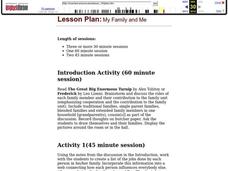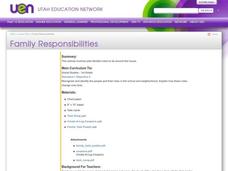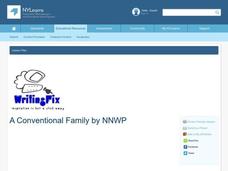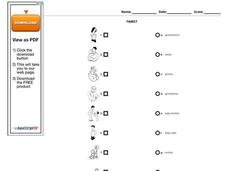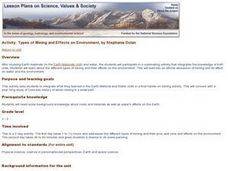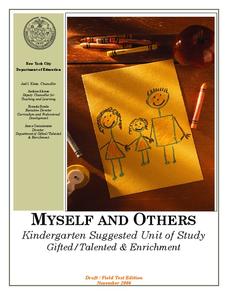Curated OER
Becoming a Member of an 1830s Family
Students compare and constrast life in an 1830s family verses a modern family. They role play the position of a family member in 1830 while wearing traditional clothing for the time period. They write journal entries to show their daily...
Read4Health
Piggybook: A Read4Health Lesson Plan
"You are pigs." With those three simple words, the lives of the Piggott family were changed forever. Read aloud the children's story Piggybook by Anthony Browne and teach your class the importance of personal responsibility, learning...
Curated OER
Oral Activity: Camping
Review camping vocabulary terms with your French language learners. Pair your learners up to practice the brief dialogues provided here. Each member in the pair gets a different sheet, and learners practice asking and answering questions.
Curated OER
Family Trees
Students trace their family history back to their great-grandparents and examine where their family is from and what types of jobs their ancestors had. They also define different terms used to describe family relations such as...
Curated OER
What Makes a Family?
Students examine the diversity of American families. In this family life lesson plan, students research the life of Michael Oher, whose life is the subject of the "The Blind Side". Students discuss their research findings and design a...
Curated OER
Purim, Esther, and Bella Abzug: Wearing Costumes and Choosing Roles
Explore the story of Bella Abzug and her role as a 1940s office worker. Collaborative learners work in groups to tell the biblical story of Esther and add details as each member participates. Comparing and contrasting the roles of Esther...
Curated OER
What's the Context Worksheet
What is context? The class researches a family treasure carefully for its hidden significance as well as its obvious story. They interview family members to gain more insight and context clues to determine point of view and meaning...
Curated OER
Family - Mish-pa-cha
Learners review and practice Hebrew vocabulary for family members, listen to and sing the "Mishpacha Song" as a class, create vocabulary flash cards for each family member, and introduce family members in Hebrew while incorporating...
Curated OER
My Family and Me
Students discuss the family unit and compare it to an ant colony. In this family lesson, students draw their family and extended family and talk about their jobs and family roles. They compare this to an ant colony and observe the work...
Curated OER
Family Traditions and Special Times
Second graders recognize that families have a history through discussions with their own family members, identify traditions and how they vary in different families, and create entries in class book about traditions in their families.
Curated OER
Family Responsibilities
First graders discuss the possible jobs each family member may do in the home. They view picture cards of each task and decide which family members would best perform the given task. They learn a song about family tasks and complete a...
US Department of Commerce
Creating and Taking a Survey
Individuals learn how to conduct surveys and collect data for the class on age, pets, and number of people at home. Scholars compare their household size to the information in the census. Pupils then develop additional questions to ask...
Curated OER
A Conventional Family
Students explore writing techniques by analyzing their own families. In this family values instructional activity, students view the film "The Incredibles" in class and discuss the different types of modern-day families. Students write...
Curated OER
My Family
Students examine the different kinds of families. In this family lesson, students discuss who is in their family, talk about how families should treat each other and how they feel about their family. Students make posters that show...
Curated OER
Social Studies: Shaking the Family Tree
Create family trees while reading "Little House in the Big Woods." After examining Laura Ingalls Wilder's family tree, compare it to a real tree's roots and branches. Conclude with interviewing family members and decorating family...
Curated OER
Language Arts: What Is a Family?
Students discuss the attributes of a successful family after listening to the poem,"What Is a Family?" After sharing information about their own families, students work in groups to act out scenes from books that were previously read...
Council for Economic Education
Satisfaction Please! (Part 2)
Simply understanding consumer rights may not help people solve their problems. Understanding who to turn to becomes key in many different scenarios. Teach the value of various organizations that fight for consumer rights through...
Curated OER
Making a Family Tree
Learners, in groups, produce a family tree using computers to facilitate research and presentation. They plan, discuss and evaluate different technologies used in this assignment.
Curated OER
Family
In this ESL family worksheet, learners examine 7 pictures that depict different members of a family. Students match these to the words or phrases that describe them.
Curated OER
Social Studies: Your Family Does What?
Sixth graders compare and contrast their own personal culture with that of Japan. They fill out questionnaires, compile the results, and match them with Japanese answers to the same forms. Students create a Venn diagram of the...
New York City Department of Education
Myself and Others
Self reflection is an important skill to reinforce in our children, and it's especially helpful to help them realize who they are in the context of their environment. A collection of lessons about self image and community encourage...
Facebook
Different Perspectives
What do people's social media profiles say about them? Explore diverse perspectives and digital citizenship in an activity designed with self-identity in mind. Pupils reflect on their own profiles, then collaborate to examine...
Equality and Human Rights Commission
Learning area 1: Who am I?
Five activities encourage scholars to dream big and celebrate the similarities and differences of those around them. Learners take part in two active practices that showcase how their peers are the same and different. Worksheets...










